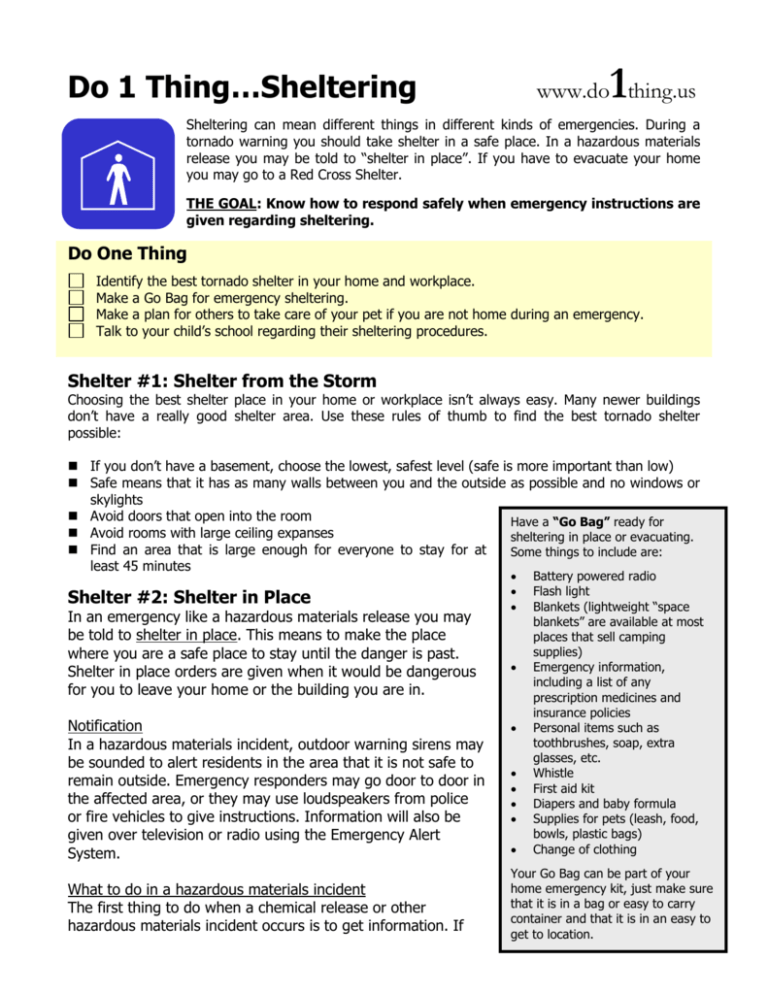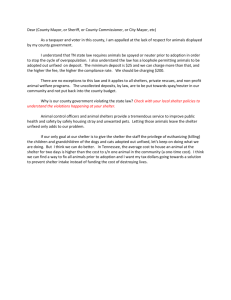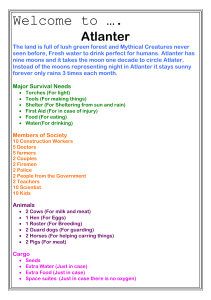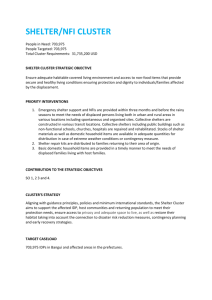March
advertisement

1 Do 1 Thing…Sheltering www.do thing.us Sheltering can mean different things in different kinds of emergencies. During a tornado warning you should take shelter in a safe place. In a hazardous materials release you may be told to “shelter in place”. If you have to evacuate your home you may go to a Red Cross Shelter. THE GOAL: Know how to respond safely when emergency instructions are given regarding sheltering. Do One Thing Identify the best tornado shelter in your home and workplace. Make a Go Bag for emergency sheltering. Make a plan for others to take care of your pet if you are not home during an emergency. Talk to your child’s school regarding their sheltering procedures. Shelter #1: Shelter from the Storm Choosing the best shelter place in your home or workplace isn’t always easy. Many newer buildings don’t have a really good shelter area. Use these rules of thumb to find the best tornado shelter possible: If you don’t have a basement, choose the lowest, safest level (safe is more important than low) Safe means that it has as many walls between you and the outside as possible and no windows or skylights Avoid doors that open into the room Have a “Go Bag” ready for Avoid rooms with large ceiling expanses sheltering in place or evacuating. Find an area that is large enough for everyone to stay for at Some things to include are: least 45 minutes Shelter #2: Shelter in Place In an emergency like a hazardous materials release you may be told to shelter in place. This means to make the place where you are a safe place to stay until the danger is past. Shelter in place orders are given when it would be dangerous for you to leave your home or the building you are in. Notification In a hazardous materials incident, outdoor warning sirens may be sounded to alert residents in the area that it is not safe to remain outside. Emergency responders may go door to door in the affected area, or they may use loudspeakers from police or fire vehicles to give instructions. Information will also be given over television or radio using the Emergency Alert System. What to do in a hazardous materials incident The first thing to do when a chemical release or other hazardous materials incident occurs is to get information. If Battery powered radio Flash light Blankets (lightweight “space blankets” are available at most places that sell camping supplies) Emergency information, including a list of any prescription medicines and insurance policies Personal items such as toothbrushes, soap, extra glasses, etc. Whistle First aid kit Diapers and baby formula Supplies for pets (leash, food, bowls, plastic bags) Change of clothing Your Go Bag can be part of your home emergency kit, just make sure that it is in a bag or easy to carry container and that it is in an easy to get to location. responders are not in the area giving instructions, turn on the television or radio to find out if your area is affected and what steps to take. Never call 911 to get information about an emergency. If you are in an area affected by the chemical release, you will be told to do one of two things: Evacuate or Shelter in Place. Listen carefully to instructions. NEVER risk your own safety or the safety of first responders for pets or personal property. Always follow emergency instructions. If you are told to shelter in place you should close all doors and windows and shut off fans and air conditioners. Take your family to a room with as few doors and windows as possible. You may be told to put towels or tape around the cracks of the windows and doors. Follow emergency instructions carefully. Make sure you take a battery powered radio with you so that you will know when the danger has passed. During an incident power in your area may be shut off. During an infectious disease outbreak, people may be isolated or quarantined to prevent the spread of disease. For more information about what that means, visit the Do 1 Thing website or contact your local health department. Shelter #3: Emergency Evacuation Shelter Emergency evacuation shelters will be opened when people are evacuated from their homes. In Mid-Michigan emergency shelters are operated by the American Red Cross. At the Red Cross Shelter: Most Red Cross shelters are opened in school gyms. You will be given a cot to sleep on, but you must provide your own bedding. Showers will be available, but may be group showers (depending on the facilities available at the shelter building). Bring ID if possible, and know your social security number. You may need to apply to FEMA for disaster assistance funding while still at the shelter. The Red Cross will not give any information about you to anyone without your permission. Meals and bottled water will be provided. Public officials will provide information about the disaster to the shelter. A nurse will be available to provide basic medical care. The Red Cross will try to help replace prescription medicines, but it will be much easier if you can bring your meds from home, or provide a list of what you are taking and how much. Pets are not allowed at Red Cross shelters, but in Mid-Michigan animal service providers will open a pet shelter if homes are evacuated. Service animals are allowed in shelters. Weapons and alcohol are not allowed in Red Cross shelters. Red Cross shelters are ADA compliant. There is never any charge for emergency sheltering. For more information http://www.redcross.org/preparedness/cdc_english/Sheltering.asp http://www.do1thing.us









